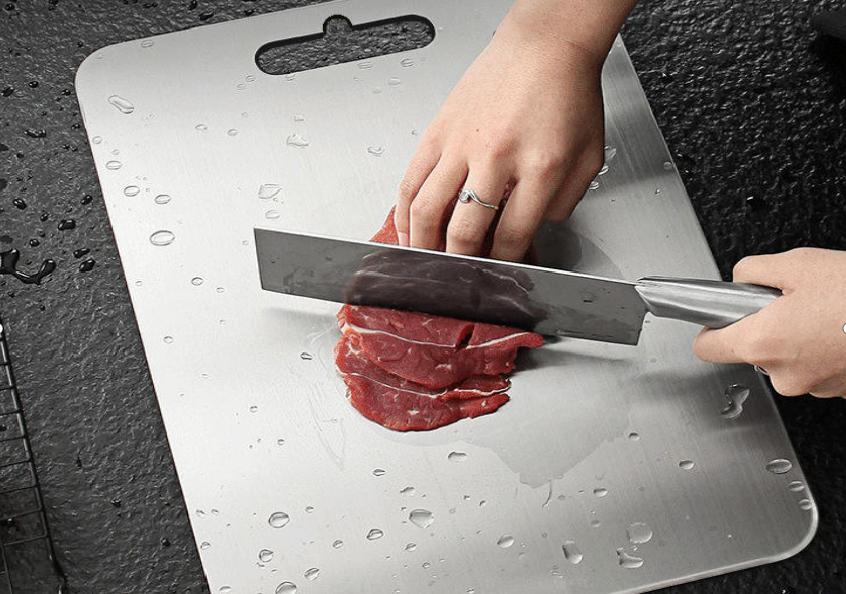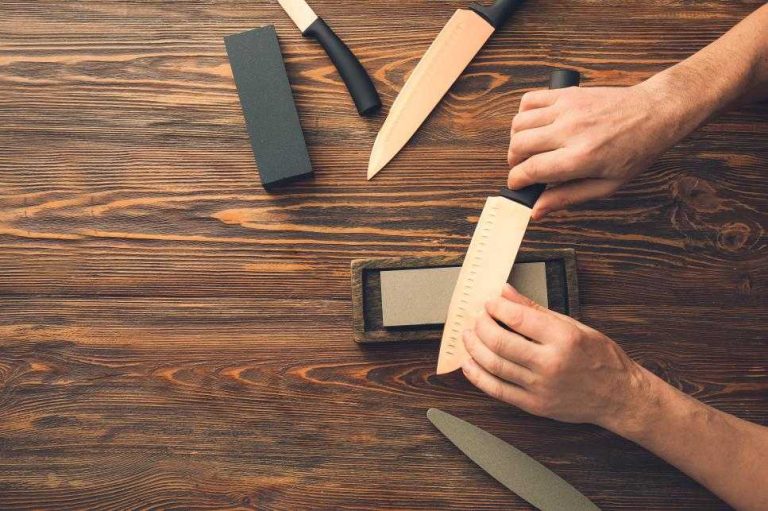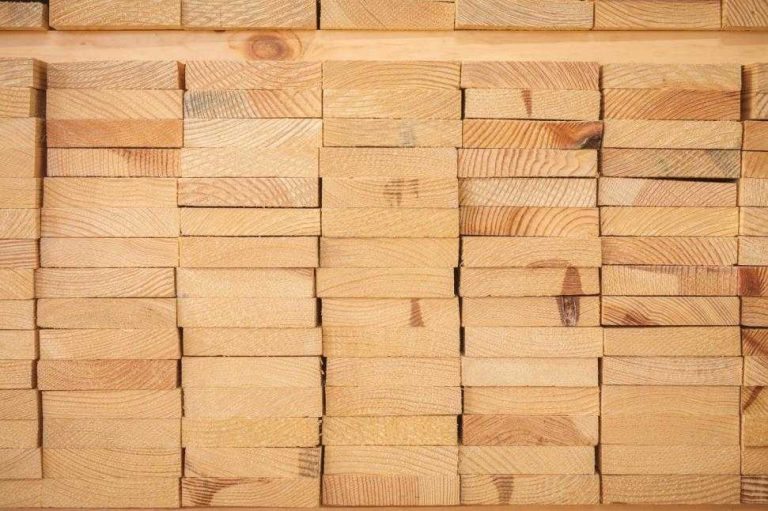Let’s get straight to the point. Yes, stainless steel cutting boards do damage knives—and faster than many other common materials.
In this article, we’ll unpack the hard truth behind “steel on steel.” We will:
- Analyze the pros and cons of stainless steel cutting boards
- Explain the science of how they dull and damage edges
- Compare them with better, knife‑friendly alternatives like wood
Most importantly, we’ll explain why choosing the right board is a critical business decision for any restaurant, brand, or professional kitchen.
Pros and Cons of Stainless Steel Cutting Boards
To be fair, stainless steel boards have their appeal. Here’s a quick summary of why people consider them—and the significant trade-offs involved.
Pros
- Exceptional Hygiene: The non-porous surface is easy to sterilize and won’t harbor bacteria.
- Extreme Durability: Resistant to cracks, warping, and high heat.
- Stain & Odor Proof: Won’t absorb liquids, colors, or smells.
Cons
- Severe Knife Damage: This is the critical, deal-breaking flaw that we will explore in detail.
- Poor User Experience: The surface is slippery, loud, and unforgiving on the hands.
- Safety Concerns: Both knives and ingredients can easily slip on the smooth surface.
Buy Wholesale Cookware and Start Scaling up with Us Today
Contact us and connect with a sales rep to get a free quote.
How Stainless Steel Systematically Destroys Your Knife’s Edge
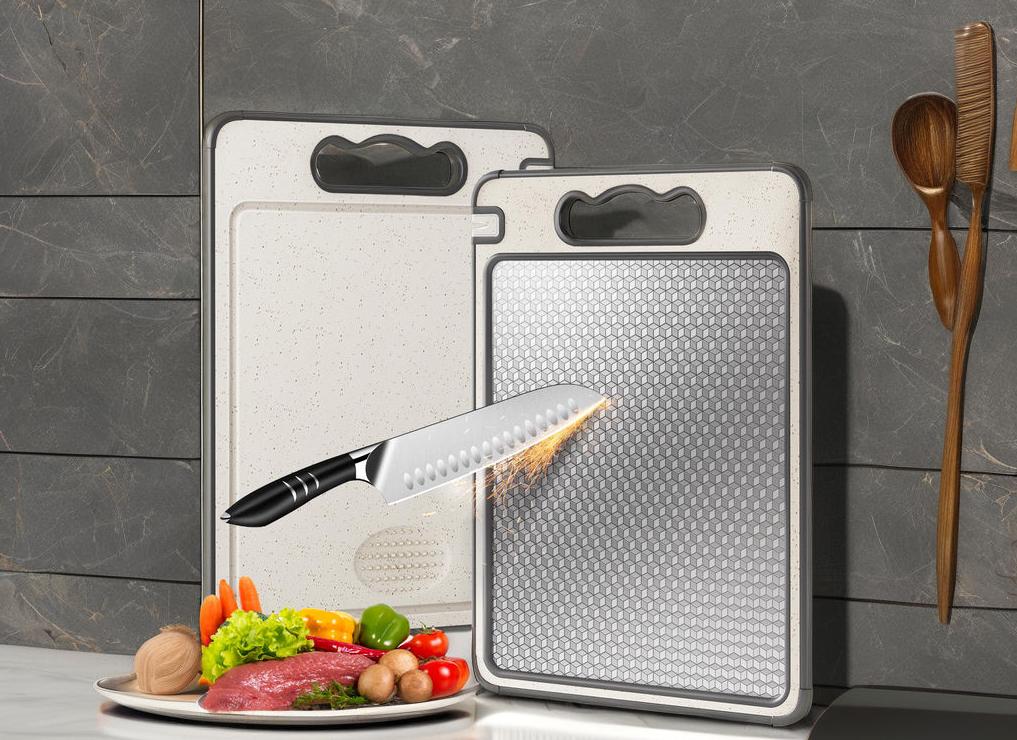
A stainless steel surface is hard and rigid, absorbing almost no impact. In contrast, wood or plastic provides a crucial “cushion” by slightly compressing. Without this cushion, every contact is a hard-on-hard collision, leading to three classic types of damage:
Damage Type 1: Micro-Chipping (For Hard, Brittle Knives)
When a very hard but more brittle knife (like a high-end Japanese knife) performs a vertical chop onto steel, its paper-thin edge cannot bend or deform. Instead, it shatters, creating microscopic chips just like glass. These chips are nearly invisible but are the reason a knife goes from gliding smoothly to snagging and tearing.
Damage Type 2: Edge Rolling (For Softer, Tougher Knives)
When a tougher knife with slightly lower hardness (like a German-style knife) is used for frequent tapping or chopping on steel, its edge doesn’t shatter. Instead, it bends or “rolls” over to one side, like the edge of aluminum foil. The metal is still there, but because the edge is no longer straight, it’s no longer sharp.
Damage Type 3: Abrasive Wear (The Universal Dulling Effect)
No matter what knife you use, the microscopic friction from cutting on steel acts like sandpaper, constantly grinding down your edge from a sharp ‘V’ to a dull ‘U’. This effect is magnified hundreds of times when you scrape ingredients sideways with the blade’s edge—the number one killer of a sharp knife.
How to Minimize Knife Damage on a Stainless Steel Board
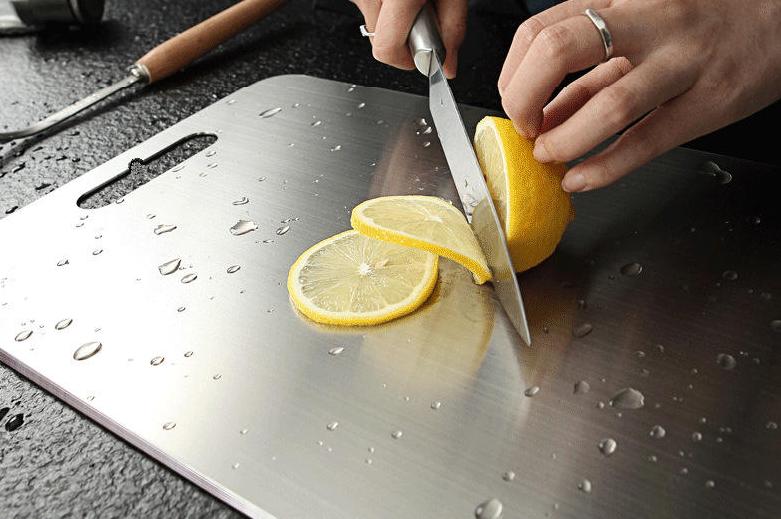
By understanding the principles of damage, we can use certain methods to reduce wear. While damage cannot be entirely avoided, correct technique and awareness can effectively slow the dulling process.
Key #1: Adjust Your Cutting Technique
The degree of wear on a hard surface is largely determined by how you use your knife.
- High-Risk Motion: Vertical chopping generates maximum impact force and is a primary cause of micro-chipping.
- Medium-Risk Actions: Pivoting on the tip or belly of the knife to “rock” through ingredients creates less instantaneous impact than a straight chop. Note: Land the blade lightly and keep the motion fluid; don’t “slam” it down.
- Low-Risk Motion: Using a push or pull slice allows the blade to glide smoothly through the food, which minimizes impact force.This distributes pressure and reduces impact.
- Core Skill: When cutting, consciously reduce pressure as the blade is about to make contact with the board to avoid direct impact.
In Summary: Using a slicing motion and controlling the force at the end of the cut are fundamental methods for protecting the blade.
Key #2: Understand the Properties of Your Knife Steel
Different steels will perform differently on a hard surface.
High-Hardness Steels
- Typically: Japanese steels (e.g., VG-10), 60+ HRC
- Strength: Excellent wear resistance; holds an edge longer.
- Risk on Hard Surfaces: Prone to micro-chipping under impact.
High-Toughness Steels
- Typically: German steels (e.g., X50CrMoV15), 55-58 HRC
- Strength: More resistant to chipping.
- Risk on Hard Surfaces: Prone to edge rolling and requires frequent honing.
In Summary: The choice of steel determines the primary form of damage; high-hardness steels tend to chip, while high-toughness steels tend to roll.
Key #3: Adopt Three Critical Habits
Three simple habits can significantly extend the sharp life of your knives.
- Use the Spine: Do not use the sharp edge to gather cut ingredients. Instead, flip the knife over and use the thick spine for this task.
- Use Different Boards for Different Tasks: This is the most effective solution. Reserve your stainless steel board for specific tasks requiring strict sanitation, like handling raw meat. For daily prep of vegetables and fruits, you should switch to a more knife-friendly wooden cutting board.
- Maintain frequently: With tougher European‑style knives, use a honing rod after each session to keep rolls from compounding into permanent damage.
Buy Wholesale Cookware and Start Scaling up with Us Today
Contact us and connect with a sales rep to get a free quote.
Cutting Board Material Comparison: Steel vs. Wood and Others

If stainless isn’t ideal for daily knife work, what should you use instead?
Stainless Steel vs. Wood
This is the classic matchup—and for good reason. In almost every knife‑critical dimension, wood is stainless steel’s opposite.
- Knife‑friendliness: Wood—especially end‑grain—is the undisputed gold standard. Wood fibers compress to “hug” the edge and then close back up, offering a self‑healing surface that cushions the apex. Among constructions: end‑grain is most forgiving, followed by edge‑grain, then face‑grain. Stainless has no give, so impact transmits straight to the edge.
For grain differences, see Face grain vs edge grain vs end grain.
- Hygiene: Many assume wood is unsanitary, yet studies show the opposite when properly cleaned and dried. Wood can inhibit bacteria inside its capillaries.
Learn more in Are wood cutting boards sanitary and Most sanitary cutting board.
- Aesthetics and feel: Wood brings warmth, a classic look, secure grip, and a pleasant, quiet cutting sound.
- Maintenance: Wood needs occasional oiling to prevent drying; stainless needs little upkeep. For superior performance and edge care, that little effort pays off.
Stainless Steel vs. Titanium
Titanium is sometimes pitched as a premium alternative to stainless. Is it better for knives? The nuanced answer depends on one thing: the specific alloy.
Here’s a concise breakdown.
| Feature | Stainless Steel Board | Titanium Board | The Deeper Impact on Knives |
|---|---|---|---|
| Hardness | Generally hard (rigid, unforgiving contact) | Highly variable (pure Ti is softer; many titanium alloys are much harder) | Some Ti coatings (e.g., TiN/PVD) are extremely hard and least knife‑friendly. |
| Weight | Heavier | Lighter | Not knife‑related, but affects portability and stability (lighter boards can slide more). |
| Cost | More affordable | Significantly more expensive | You may pay a premium without gaining any real knife‑friendliness. |
| Hygiene | Excellent (non‑porous, easy to sanitize) | Excellent (non‑porous, easy to sanitize) | Both perform well but still require thorough scrubbing of scratches. |
| Noise | Loud | Loud (sometimes subjectively a touch lower) | Both are noisier than wood or plastic due to metallic resonance. |
Bottom line:
- In any case, end-grain wood remains far more knife-friendly than any metal board.
- Pure Ti ≈ typical stainless and both will dull knives, but pure Ti is slightly gentler.
- Ti-6Al-4V (6% aluminum, 4% vanadium) or Hard-coated Ti is clearly harsher on edges than stainless.
What About Plastic and Bamboo Boards?
- Plastics: Softer than metal and kinder to edges, but they scratch easily. Deep grooves can harbor bacteria and are harder to clean thoroughly.
- Bamboo: Often grouped with wood, but botanically a grass. Typically harder and more silica‑rich than many hardwoods, so it’s less forgiving to edges. Learn more in Bamboo vs wood cutting board.
Buy Wholesale Cookware and Start Scaling up with Us Today
Contact us and connect with a sales rep to get a free quote.
Why Businesses Prefer Wood Cutting Boards
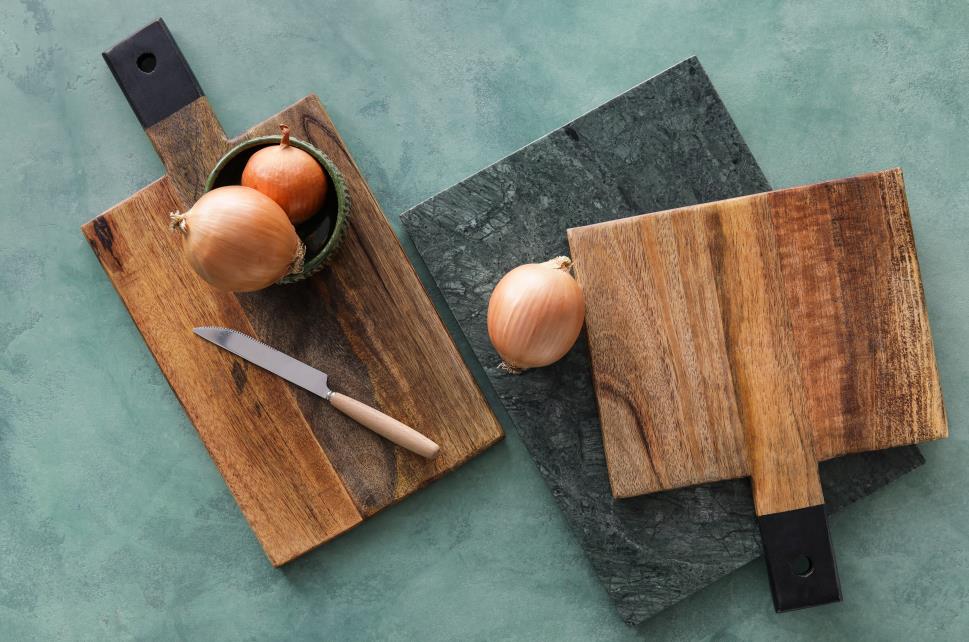
For restaurants, culinary brands, and kitchenware retailers, board choice goes beyond personal preference—it’s a strategic decision.
- Protect your investment: Quality knives are capital assets. Pairing them with knife‑friendly wood boards reduces sharpening frequency and prolongs the life of your most important tools.
- Brand image and guest experience: A beautiful hardwood board—such as acacia or teak—elevates your kitchen’s look and feel. For brands, custom‑engraved boards become effective marketing tools that signal quality and attention to detail.
- Choosing the right wood matters: Not all woods are equal. Selecting the best wood for cutting boards means balancing hardness, grain, and durability.
For a full overview, explore our guides to the best cutting board material and the best cutting board for knives.
LeeKnives: Your Partner for Wholesale & Custom Cutting Boards
At LeeKnives, we don’t just sell products—we deliver complete culinary solutions. We understand the critical synergy between a great knife and the right board.
We offer end‑to‑end services for business clients:
- Cutting board wholesale: Outfit your restaurant, retail program, or brand with durable, knife‑friendly hardwood boards sourced for quality.
- Custom and OEM: We can build to your specific cutting board sizes and shapes, and laser‑engrave your logo for truly branded products.
- The perfect pairing: As knife specialists, we also provide wholesale and OEM for kitchen and outdoor knives—source both knives and boards from one reliable partner.
Ready to equip your business with premium wood boards that protect your tools and elevate your brand? Contact our team now for a wholesale quote or to discuss your custom OEM project.
Browse our premium wood cutting board collection. →
Frequently Asked Questions
Q1: Are stainless steel cutting boards completely useless?
A: Not at all. They excel in specific, limited use cases—like raw meat processing—where top‑tier sanitation is the priority. For routine prep, though, we don’t recommend them because they severely accelerate dulling.
Q2: Which cutting board best prevents dulling?
A: End‑grain wood boards are widely regarded as the gold standard thanks to their self‑healing fiber structure, followed by quality HDPE. For side‑by‑side comparisons, see the best cutting board for knives.
Q3: How should I sanitize a wood cutting board properly?
A: After daily use, hot water and dish soap are enough. For deeper cleaning, you can use vinegar or a hydrogen peroxide solution. Find details in our guide to Are wood cutting boards sanitary.
